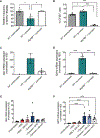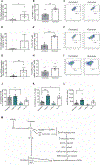Inflammation induces stress erythropoiesis through heme-dependent activation of SPI-C
- PMID: 31506384
- PMCID: PMC6904953
- DOI: 10.1126/scisignal.aap7336
Inflammation induces stress erythropoiesis through heme-dependent activation of SPI-C
Abstract
Inflammation alters bone marrow hematopoiesis to favor the production of innate immune effector cells at the expense of lymphoid cells and erythrocytes. Furthermore, proinflammatory cytokines inhibit steady-state erythropoiesis, which leads to the development of anemia in diseases with chronic inflammation. Acute anemia or hypoxic stress induces stress erythropoiesis, which generates a wave of new erythrocytes to maintain erythroid homeostasis until steady-state erythropoiesis can resume. Although hypoxia-dependent signaling is a key component of stress erythropoiesis, we found that inflammation also induced stress erythropoiesis in the absence of hypoxia. Using a mouse model of sterile inflammation, we demonstrated that signaling through Toll-like receptors (TLRs) paradoxically increased the phagocytosis of erythrocytes (erythrophagocytosis) by macrophages in the spleen, which enabled expression of the heme-responsive gene encoding the transcription factor SPI-C. Increased amounts of SPI-C coupled with TLR signaling promoted the expression of Gdf15 and Bmp4, both of which encode ligands that initiate the expansion of stress erythroid progenitors (SEPs) in the spleen. Furthermore, despite their inhibition of steady-state erythropoiesis in the bone marrow, the proinflammatory cytokines TNF-α and IL-1β promoted the expansion and differentiation of SEPs in the spleen. These data suggest that inflammatory signals induce stress erythropoiesis to maintain erythroid homeostasis when inflammation inhibits steady-state erythropoiesis.
Copyright © 2019 The Authors, some rights reserved; exclusive licensee American Association for the Advancement of Science. No claim to original U.S. Government Works.
Figures







Similar articles
-
Stress erythropoiesis: definitions and models for its study.Exp Hematol. 2020 Sep;89:43-54.e2. doi: 10.1016/j.exphem.2020.07.011. Epub 2020 Aug 2. Exp Hematol. 2020. PMID: 32750404 Free PMC article. Review.
-
Gdf15 regulates murine stress erythroid progenitor proliferation and the development of the stress erythropoiesis niche.Blood Adv. 2019 Jul 23;3(14):2205-2217. doi: 10.1182/bloodadvances.2019000375. Blood Adv. 2019. PMID: 31324641 Free PMC article.
-
Stress Erythropoiesis is a Key Inflammatory Response.Cells. 2020 Mar 6;9(3):634. doi: 10.3390/cells9030634. Cells. 2020. PMID: 32155728 Free PMC article. Review.
-
Erythropoietin stimulates spleen BMP4-dependent stress erythropoiesis and partially corrects anemia in a mouse model of generalized inflammation.Blood. 2010 Dec 23;116(26):6072-81. doi: 10.1182/blood-2010-04-281840. Epub 2010 Sep 15. Blood. 2010. PMID: 20844235
-
Murine erythroid short-term radioprotection requires a BMP4-dependent, self-renewing population of stress erythroid progenitors.J Clin Invest. 2010 Dec;120(12):4507-19. doi: 10.1172/JCI41291. Epub 2010 Nov 8. J Clin Invest. 2010. PMID: 21060151 Free PMC article.
Cited by
-
The crosstalk between parenchymal cells and macrophages: A keeper of tissue homeostasis.Front Immunol. 2022 Nov 24;13:1050188. doi: 10.3389/fimmu.2022.1050188. eCollection 2022. Front Immunol. 2022. PMID: 36505488 Free PMC article. Review.
-
Yap1 promotes proliferation of transiently amplifying stress erythroid progenitors during erythroid regeneration.Exp Hematol. 2019 Dec;80:42-54.e4. doi: 10.1016/j.exphem.2019.11.002. Epub 2019 Nov 19. Exp Hematol. 2019. PMID: 31756359 Free PMC article.
-
GM-CSF impairs erythropoiesis by disrupting erythroblastic island formation via macrophages.J Transl Med. 2022 Jan 3;20(1):11. doi: 10.1186/s12967-021-03214-5. J Transl Med. 2022. PMID: 34980171 Free PMC article.
-
Association between Neutrophil Gelatinase-Associated Lipocalin and Fetal Hemoglobin Levels in Patients with Type 2 Diabetes Mellitus.Biomed Res Int. 2021 Oct 20;2021:8383875. doi: 10.1155/2021/8383875. eCollection 2021. Biomed Res Int. 2021. PMID: 34722773 Free PMC article.
-
The Multiple Facets of Iron Recycling.Genes (Basel). 2021 Aug 30;12(9):1364. doi: 10.3390/genes12091364. Genes (Basel). 2021. PMID: 34573346 Free PMC article. Review.
References
-
- Jurado RL, Iron, infections, and anemia of inflammation. Clin. Infect. Dis 25, 888–895, (1997). - PubMed
-
- Prakash D, Anemia in the ICU: Anemia of chronic disease vesus anemia of acute illness. Crit. Care Clin 28, 333–343 (2012). - PubMed
-
- Libregts SF, Gutiérrez L, de Bruin AM, Wensveen FM, Papadopoulos P, van Ijcken W, Ozgur Z, Philipsen S, Nolte MA, Chronic IFN-γ production in mice induces anemia by reducing erythrocyte life span and inhibiting erythropoiesis through an IRF-1/PU.1 axis. Blood 118, 2578–2588 (2011). - PubMed
Publication types
MeSH terms
Substances
Grants and funding
LinkOut - more resources
Full Text Sources
Molecular Biology Databases

